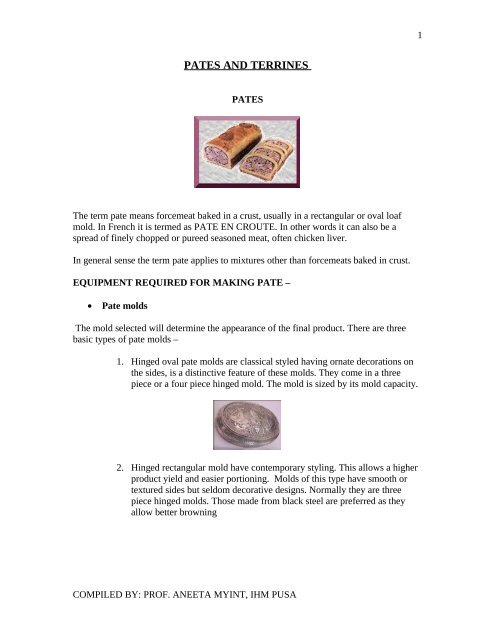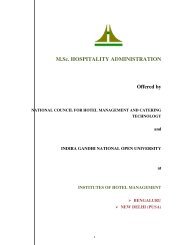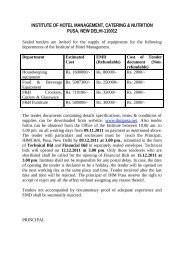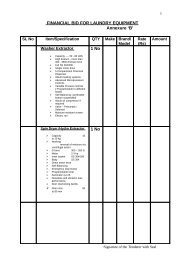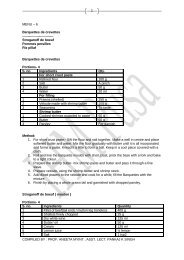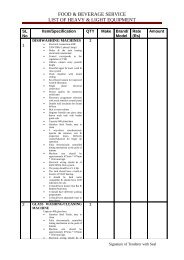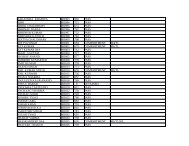Create successful ePaper yourself
Turn your PDF publications into a flip-book with our unique Google optimized e-Paper software.
1<br />
<strong>PATES</strong> <strong>AND</strong> <strong>TERRINES</strong><br />
<strong>PATES</strong><br />
The term pate means forcemeat baked in a crust, usually in a rectangular or oval loaf<br />
mold. In French it is termed as PATE EN CROUTE. In other words it can also be a<br />
spread of finely chopped or pureed seasoned meat, often chicken liver.<br />
In general sense the term pate applies to mixtures other than forcemeats baked in crust.<br />
EQUIPMENT REQUIRED FOR MAKING PATE –<br />
• Pate molds<br />
The mold selected will determine the appearance of the final product. There are three<br />
basic types of pate molds –<br />
1. Hinged oval pate molds are classical styled having ornate decorations on<br />
the sides, is a distinctive feature of these molds. They come in a three<br />
piece or a four piece hinged mold. The mold is sized by its mold capacity.<br />
2. Hinged rectangular mold have contemporary styling. This allows a higher<br />
product yield and easier portioning. Molds of this type have smooth or<br />
textured sides but seldom decorative designs. Normally they are three<br />
piece hinged molds. Those made from black steel are preferred as they<br />
allow better browning<br />
COMPILED BY: PROF. ANEETA MYINT, IHM PUSA
2<br />
3. Tapered loaf pans give pate a home-like appearance. The sides of the mold<br />
taper for easy removal<br />
• Pastry wheels<br />
• Scissors<br />
• Palette knives<br />
• Round cutters<br />
• Aluminum foil<br />
PREPARATION<br />
The preparation of pate is done in 5 stages<br />
1. PRE-PREPARATION<br />
• Prepare the dough<br />
• Prepare the forcemeat<br />
• Roll the dough about 1/8 th inch thick and about the size of the sheet pan<br />
• Using the assembled hinged mold, mark the dough for the main and the<br />
cap pieces.<br />
• The bottom and the four walls of the mold to be covered with the dough.<br />
COMPILED BY: PROF. ANEETA MYINT, IHM PUSA
3<br />
• Allow for a ½ inch overhang on all the sides.<br />
• The capping piece should be the size of the bottom<br />
• Cut 2 chimney rings from an extra piece of dough using 1 inch and ½ inch<br />
round cutter.<br />
2. ASSEMBLING THE PATE<br />
• Lightly oil the assembled mold.<br />
• Fold the main piece of dough length wise. It should drop easily into the mold.<br />
• It should cover all the four walls and the bottom of the mold.<br />
• Using a small ball of scrap dough carefully press the dough into the corners of the<br />
mold.<br />
• Cover and refrigerate the lined mold for one hour.<br />
• Fill the mold with well chilled forcemeat ½ inch short of the top edge.<br />
• The forcemeat should be placed in several layers using a palette knife to press the<br />
forcemeat to reduce the formation of the air pockets.<br />
• Fold the overhanging dough over the top of the forcemeat.<br />
• Lightly egg wash the dough covering the top.<br />
• Lightly eggs wash the face of the capping dough.<br />
• Lay the capping face, egg wash side down, on top of the pate.<br />
3. INSERTING THE CHIMNEYS<br />
• Chimneys are placed in the pate to allow steam to escape. If chimneys are not<br />
present the steam can crack the crust.<br />
COMPILED BY: PROF. ANEETA MYINT, IHM PUSA
4<br />
4. COOKING THE PATE<br />
Cooking the pate is divided into two stages-<br />
• Browning Stage – without egg washing the top of the pate, cover the pate with a<br />
foil. Place in a pre heated oven at 475 degrees F, for 10 minutes. Remove from<br />
the oven and allow rest for 15 minutes.<br />
• Cooking Stage – uncover and lightly egg wash the top of the pate. Place in a<br />
preheated oven at 350 degrees F until an internal temperature is reached to 150<br />
degrees F<br />
NOTE: The temperature can be taken through the chimney<br />
5. FINISHING THE PATE –<br />
The pate is not complete when it is removed from the oven. It must be first filled<br />
with aspic.<br />
• Allow the pate to rest at room temperature for 15 minutes. This will allow the<br />
juices and fat those have come out of the pate to be absorbed back.<br />
• Carefully fill the chimneys with a good quality aspic jelly.<br />
• Allow the pate to chill overnight before removal and slicing.<br />
COMPILED BY: PROF. ANEETA MYINT, IHM PUSA
5<br />
<strong>TERRINES</strong><br />
<strong>TERRINES</strong> are the closest cousin of pates.<br />
The terrine vessel is an oblong, earthenware mold. It can also be enameled cast iron .<br />
Terrines are the pate cooked in terrine mold and not a crust.<br />
Terrines can also be made using pre-cooked paste of meat, fish or vegetable purees bound<br />
cold with gelatin or hot with eggs.<br />
Terrines can be served directly from the mold or removed.<br />
They are most often served cold however they can also be served hot.<br />
EQUIPMENT REQUIRED<br />
• Terrine molds<br />
• Plastic food film<br />
• Palette knife<br />
• Water bath with a rack<br />
COMPILED BY: PROF. ANEETA MYINT, IHM PUSA
6<br />
PREPARATION<br />
The preparation can be divided into 4 stages.<br />
1. PRE-PREPARATION- The first step is to select a suitable mold.<br />
• Lightly oil the mold<br />
• Line the mold with single piece of plastic film, large enough to cover<br />
the bottom and the four sides.<br />
• Prepare the forcemeat.<br />
2. ASSEMBLING THE TERRINE<br />
• Fill the terrine half with forcemeat, being careful not to form the air<br />
pockets.<br />
• Place the garnishes if any.<br />
• Fill the terrine with the remaining forcemeat to the shoulder of the<br />
mold.<br />
• Fold the overhanging plastic sheet over the forcemeat.<br />
• Place the lid on the terrine.<br />
3. COOKING THE TERRINE-<br />
• Assemble the water bath<br />
• Place terrine in the water bath<br />
• Place in the pre heated oven at 325 degrees F<br />
• Cook to an internal temperature of 140 degrees F<br />
• Remove from the water bath<br />
• Cool at room temperature for 30 minutes.<br />
4. PRESSING <strong>TERRINES</strong>-<br />
• A cooked terrine is pressed by removing the lid and placing a<br />
metal plate, cut to fit the opening of the terrine, on top of the plate<br />
and the terrine is refrigerated overnight<br />
COMPILED BY: PROF. ANEETA MYINT, IHM PUSA
7<br />
GALANTINES<br />
Galantine is a boned poultry or game animal stuffed with forcemeat.<br />
Modern galantines are more often rolled into an even, elongated shape resembling a thick<br />
sausage.<br />
The meat of the poultry or game may be left attached to the skin in its natural position.<br />
Poultry or game may also be skinned first and the prime pieces, such as the breast, used<br />
for the inlays<br />
Once assembled, the galantine is poached and left to cool in a rich stock<br />
The stock is made from the animal which has been used.<br />
When cooled, galantines may be braised briefly<br />
COMPILED BY: PROF. ANEETA MYINT, IHM PUSA
8<br />
PREPARATION<br />
The preparation of galantine is divided into three stages.<br />
1. PRE-PREPARATION-<br />
• Begin with a chicken which has been plucked, dressed, washed and<br />
singed.<br />
• Remove the wings at the second joint and reserve for the stock.<br />
• Skin the bird.<br />
• Remove the meat from the bones.<br />
• Marinate the breast meat and skin for 3 hours with brandy, white wine,<br />
curing salt, salt and pepper.<br />
• Prepare the stock from the bones.<br />
• Prepare the forcemeat<br />
2. ASSEMBLING THE GALANTINE<br />
• Assembling the galantines is simply a matter of placing and rolling.<br />
• Dampen a piece of cheesecloth. Fold in half and spread on the work<br />
table.<br />
• Dust the skin lightly with a pinch of dry gelatin, salt and pepper.<br />
• Spread the forcemeat on the skin, one inch thick, leaving one inch<br />
margin of skin all around.<br />
• Place the marinated breasts lengthwise, on the forcemeat with the<br />
thinner ends of the breast, overlapping in the middle.<br />
• Using the cheesecloth, roll the galantine away from you<br />
• Make a snug roll free of any large wrinkles in the cheesecloth.<br />
COMPILED BY: PROF. ANEETA MYINT, IHM PUSA
9<br />
• Gather the cheesecloth at one end of the roll and tie like a toffee.<br />
• Do the same with the other end also.<br />
3. COOKING THE GALANTINE<br />
• Place the galantine in a big brazier.<br />
• Cover with the prepared stock and place on the range.<br />
• Bring the temperature of the stock up to 190 degrees F<br />
• Poach the galantine till the internal temperature reaches up to 170<br />
degrees F<br />
• Refrigerate overnight in the same stock<br />
4. PRESENTATION –<br />
• Traditionally the galantines are sliced and served with small cubes<br />
of delicate aspic.<br />
ROULADES<br />
The term roulade can be applied to contemporary products prepared in the manner which<br />
is similar to galantine, yet do not satisfy the classical definition of the galantines.<br />
They are generally made by boneless flank steaks, butter flied, pounded, spread and then<br />
a filling of forcemeat or any other minces are added and is rolled in the style of the<br />
galantine<br />
The roulade is then either roasted or poached.<br />
The variety of roulade is unlimited.<br />
COMPILED BY: PROF. ANEETA MYINT, IHM PUSA
10<br />
The roulades are sliced and served hot or cold.<br />
BALLOTINES<br />
This is the smaller relative of galantines<br />
It is an excellent method for using the leg portion of poultry when the breasts have been<br />
used in the other preparations<br />
The legs are de-boned, leaving the meat and the skin intact.<br />
Forcemeat or any other mince is stuffed into the pocket and then the pocket is carefully<br />
sealed.<br />
The ballotine is normally roasted or braised.<br />
It can be glazed with aspic or coated with chaud-froid sauce and can be served cold or<br />
hot.<br />
COMPILED BY: PROF. ANEETA MYINT, IHM PUSA
11<br />
PARFAITS<br />
This is the French word for PERFECT<br />
It refers to two distinctly different items.<br />
1. One is a frozen mousse like dessert of lightened still frozen ice cream, which is<br />
served in a tall glass.<br />
2. Other parfait is a savory terrine which uses vegetables, fish, shell fish, poultry or<br />
other light meats. It is distinguished by its very fine texture and preparation<br />
methods.<br />
• It is based on raw mousseline forcemeat. Whipped cream is incorporated<br />
into this mixture for lightness. This mixture is set with gelatin, not by heat.<br />
• The second method is based on a puree of cooked meat or vegetable<br />
fortified with egg whites and is lightened with cream. The mixture is then<br />
molded and poached.<br />
• A parfait can be cooked in a terrine mold, large timbale or loaf pan.<br />
COMPILED BY: PROF. ANEETA MYINT, IHM PUSA
12<br />
MOUSSE <strong>AND</strong> MOUSSELIN<br />
These terms have two applications.-<br />
MOUSSE – The mixture is a cooked puree, bound with gelatin and lightened with cream,<br />
is set by chilling.<br />
MOUSSELINE FORCEMEAT – Is composed of raw pureed meat or fish combined with<br />
eggs and cream set by cooking<br />
MOUSSE <strong>AND</strong> MOUSSELINE – These terms also refer to the size of the finished dish.<br />
A mousse, hot or cold, is a dish made of mousse mixture or mousseline forcemeat. It is<br />
molded in a terrine, suitable to serve more than two people.<br />
COMPILED BY: PROF. ANEETA MYINT, IHM PUSA
13<br />
A mousseline is a small quenelle or molded individual portion of mousse mixture. Serve<br />
cold.<br />
COMPILED BY: PROF. ANEETA MYINT, IHM PUSA


